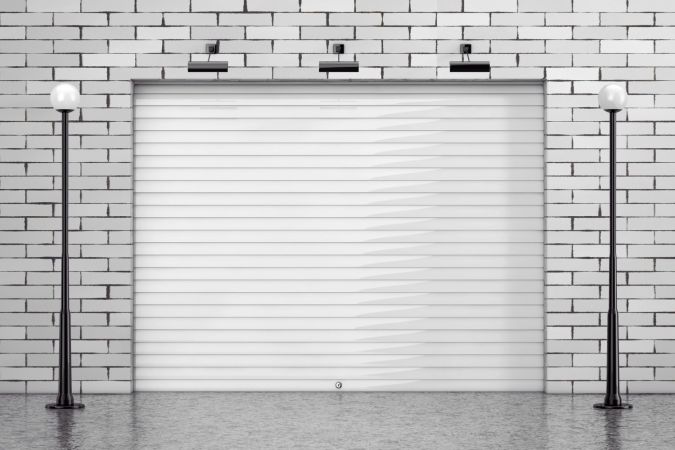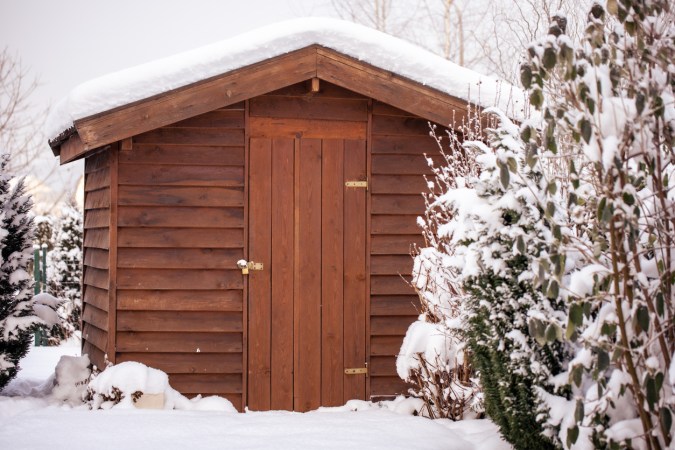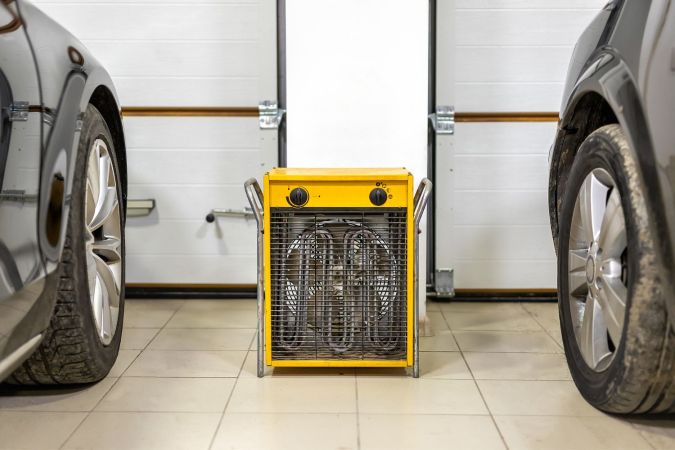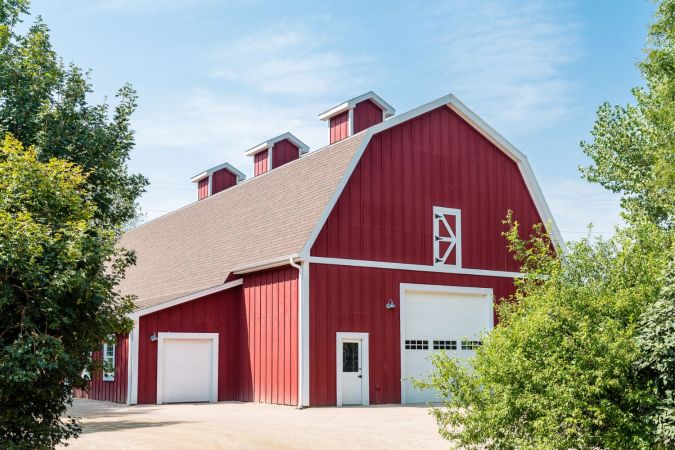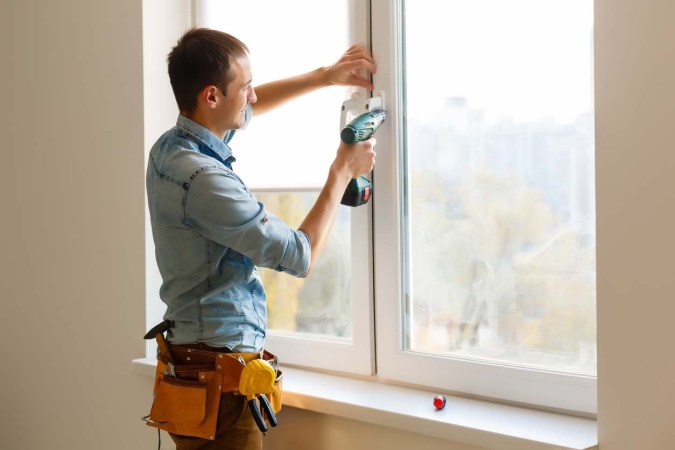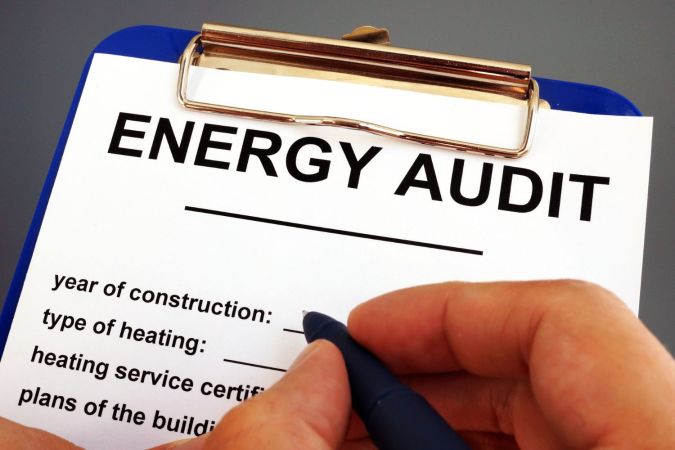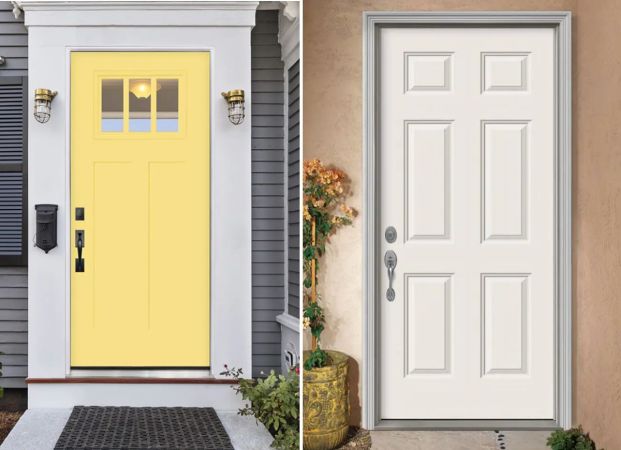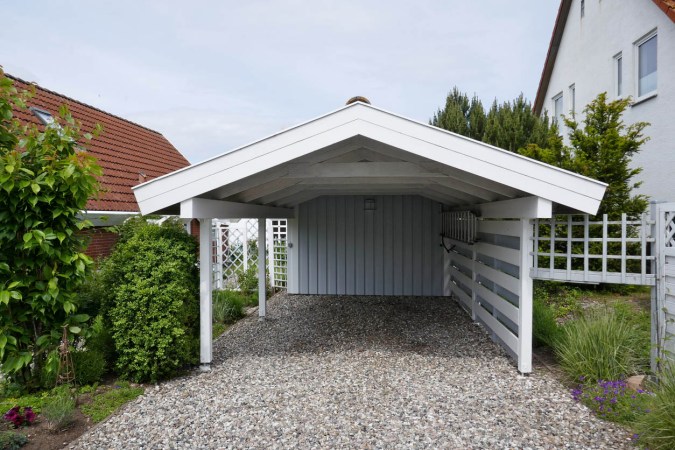We may earn revenue from the products available on this page and participate in affiliate programs. Learn More ›
- Typical Range: $2,000 to $6,000
- National Average: $4,500
Homeowners choose to insulate their garages for a number of reasons. One of the most common reasons is to reduce the energy required to heat and cool their home. Others do it to reduce garage noise invading other areas of the home, while some homeowners add insulation to increase their home’s value. Finally, many homeowners consider garage insulation as a way to gain more usable space in their home. Insulation costs may seem high, but they can be worth it if the homeowner gains additional usable space.
Whatever the reason, insulating a garage is an investment. The national average cost to insulate garage space is $4,500, though some projects can be as affordable as $2,000. In larger spaces or more complex projects, homeowners may spend as much as $6,000 to insulate their garages. This guide will cover how to estimate a garage insulation job, the benefits of insulating a garage, and ways to save money on a garage insulation project.
Factors in Calculating the Cost to Insulate a Garage
Whether it’s a renovation project or new construction, insulating a garage can be a beneficial home improvement project. But how much does it cost to insulate garage walls, doors, and ceilings? A variety of factors go into how much the project will cost, including the following.

Garage Size
Garage size is one of the most influential factors when homeowners are estimating an insulation installation. Generally speaking, the more space a garage has, the more insulation it will likely need. For example, the cost to insulate 400-square-foot garage spaces will almost always be less expensive than the cost to insulate 600-square-foot spaces.
On the lower end, a single-car garage measuring approximately 240 square feet costs between $572 and $6,600, depending on factors such as the insulation type and material.
As to be expected, the price goes up significantly for a garage that holds more vehicles. The cost to insulate two-car garages ranges from $780 to $9,000, while the cost to insulate three-car garages typically runs between $1,300 and $15,000.
Insulation Type
There are five main types of insulation that homeowners have to choose from. Many homeowners choose to mix and match them, as each one tends to fit better in different spaces. But with unique price points, a homeowner can end up with a wide potential cost range.
Batt insulation is the cheapest available option. It costs anywhere from $0.65 to $2 per square foot and is most commonly used in walls and ceilings. Blown-in insulation is another affordable option costing between $1.65 and $3.80 per square foot; it’s usually used to fit into empty cavities found behind drywall. Foam board ranges from $2.40 to $3.75 per square foot and is most commonly used in exterior spaces. Spray foam is a type of insulation that can be used virtually anywhere; the cost of spray foam insulation in garages is between $3.15 and $7.50 per square foot. Finally, the most expensive option is rigid board, which costs $5.75 to $15 per square foot and is a great insulation choice for soundproofing purposes.
Insulation Material
There are nine standard materials used for insulation, with many being used only for specific purposes. Each has its unique pros and cons, so homeowners will want to do their research before deciding on the best insulation for garage installations.
On the cheaper end are fiberglass, blue jean, cellulose, and sheep wool. These options vary in price but can be purchased for $0.40 to $2.80 per square foot. In the mid-range are rockwool, polyisocyanurate, and wood fiber. These options range from $1.40 to $6.75 per square foot. Finally, the most expensive options are cork and polystyrene, which tend to cost between $1 and $15 per square foot.
Insulation Location
The location of the insulation installation heavily influences price. Accessing some areas requires more time and effort, resulting in more complex job scopes and additional labor hours.
For example, the cost to insulate garage doors is the least expensive, since they’re easily accessible. Homeowners can expect to pay between $500 and $700. With a typical price range of $600 to $900, floors don’t cost much more to insulate. The cost to insulate garage ceiling space is anywhere from $260 to $3,000. When estimating the cost to insulate garage attic space or a roof, homeowners can expect to pay between $1,600 and $3,000. Finally, the cost to insulate garage walls tends to be the highest, costing anywhere from $780 to $9,000.
These costs are assuming an average two-car garage, with approximately a 400- to 600-square-foot surface area. Each location’s price range is also influenced by insulation type and material.
Insulation R-Value
R-value is a term likely unfamiliar to many homeowners, but it is very important to consider it when installing insulation. It measures how resistant a material is to transferring warmth. This means that materials with higher R-values hold heat more effectively.
Different insulation types offer different R-values. Batt insulation has an R-value range of 2.2 to 4.5, while blown-in varies from 2.5 to 4.3. Rigid board is 3.6 to 4.2, foam board is 3.6 to 6.5, and spray foam is 3.8 to 7.
Generally speaking, the higher the R-value, the more expensive the insulation type. This isn’t always the case, so homeowners will want to balance their budget against a higher R-value to get the most impact out of their investment. This is why figuring out how much insulation a project requires is an important step.
Labor
The final factor involved in the cost of insulation is labor. This, once again, is largely dependent on type and material. Labor costs tend to range from $300 to $4,000 for garage insulation. For additional clarification, homeowners can break down labor costs by insulation type.
- Batt: $0.25 to $0.80 per square foot
- Blown-in: $1.15 to $1.30 per square foot
- Foam board: $1.40 to $2.50 per square foot
- Spray foam: $50 to $100 per hour
- Rigid board: $1.50 to $2.50 per square foot

Additional Costs and Considerations
In some garage insulation installations, a homeowner may come across a few additional costs outside the normal job scope. While higher costs are never ideal, some scenarios offer additional value. Homeowners will want to keep the following considerations in mind when budgeting for a garage insulation project.
Energy Audit
Although an energy audit is not necessary, it can help pinpoint trouble areas in a garage that may be wasting energy. This can save on energy costs, helping to defray the cost of installation while ensuring a garage’s insulation can stand up to the temperature monitoring needs of the space.
An energy audit before a garage insulation project is another cost but can be worth the investment if it helps save money in the long run. Homeowners can expect to pay between $145 and $420 for an energy audit. This cost would cover an evaluation of both the garage and living spaces of a home, so it may reveal additional issues that may have a bigger impact on cutting energy costs once addressed.
Drywall Installation
The average cost to insulate and drywall garage space for two cars is between $1,680 and $10,200. Drywall isn’t required in a garage (except for walls between the garage and living area of a home), but it does offer some nice benefits.
One benefit is that drywall is highly resistant to fire. With garages having multiple potential fire hazards, like power tools and vehicles, it’s beneficial to have a fire-resistant material in the space. Drywall also gives a more finished look, which can be appealing if a homeowner uses their insulated garage as an additional living space. Additionally, drywall can increase the structural integrity of a home while adding an extra layer of insulation and soundproofing.
Soundproofing
Soundproofing a garage reduces noise distractions from the outside and inside the home. This can be very beneficial for someone who works out of their garage or retreats to the space for peace and quiet.
Soundproofing a garage may allow for the opposite as well. A homeowner can be as loud as they want in a soundproofed garage. Whether they’re operating power tools or holding band practice, they won’t disturb their neighbors and family members.
And as an added bonus, soundproofing can improve the sound quality inside a garage. While insulation has many sound-absorbing qualities, a homeowner who is serious about blocking out noise may want to budget for soundproofing services during their garage wall insulation project. Soundproofing costs between $230 and $450.
Mold Remediation
A musty, damp smell in a garage can be a sign of mold. A homeowner will want to look for black, white, or gray patches of mold on the ceiling or walls if a garage has been exposed to excessive moisture after a recent flood or leak. Powdery-looking paint is another potential sign of a mold issue inside a garage.
Mold can cause watery eyes, a runny nose, itching, wheezing, and headaches. It’s always best to have mold taken care of as soon as possible. Costs vary based on the space and the mold issue’s seriousness, but homeowners can expect to pay between $1,500 and $3,500 for mold remediation as they prepare for a garage insulation project.
Weatherstripping
Weatherstripping offers protection against air that leaks around doors and windows. In a garage, weatherstripping around the garage door can be quite helpful in maintaining a comfortable temperature inside the space. The best insulated garage doors often include additional weatherstripping material to ensure an air-tight seal when closed.
The cost of weatherstripping will depend on how much material and time is needed to complete the job. The more windows and movable components a garage has, the more expensive it will be to weatherstrip the space. But generally, homeowners can expect to pay between $130 and $400 for weatherstripping their garage.
Cost to Insulate Garage by Insulation Type
There are several different types of insulation on the market, and all offer different benefits, disadvantages, and price ranges. Homeowners should consider their budget and goals when choosing an insulation type for their garage.
Batt
Batt insulation can be made out of many different materials, though fiberglass is the most common. It’s easy to work with and relatively inexpensive. Batt insulation is best for DIY projects and unfinished garage ceilings, floors, and walls. While this type of insulation can be installed in a garage with existing drywall, there may need to be repairs after the installation, and that can increase the project cost.
Whether choosing fiberglass batt insulation to do a quick DIY project or to save costs on a professional installation, homeowners can expect to pay between $0.65 and $2.00 per square foot.
Blown-In
Blown-in insulation is a good choice for attic spaces above a garage and drywall walls. Most blown-in insulation is made from fiberglass and cellulose. Both materials are ideal for filling cavities, so blown-in is not recommended for walls without drywall. If batt insulation isn’t an option due to the risk of drywall repair, blown-in can be considered. It should also be noted that blown-in insulation is more efficient than fiberglass batting and can reduce condensation, limiting the risk for mold.
When homeowners are estimating a garage ceiling insulation, blown-in insulation costs can be affordable, with a price range between $1.65 and $3.80 per square foot.
Foam Board
For those who want to insulate their garage but don’t want the look or additional cost of drywall, foam board insulation is an excellent option. Many garage insulation kits include foam board, since it’s an easy type of insulation for a DIY project. However, not all municipalities allow foam boards under local building codes. A homeowner will also want to check that their foam board insulation has been flame-tested for safety.
Foam board is also a great choice for metal garage insulation during exterior renovations or for garages that are fully insulated on the interior but still need a bit more insulation for comfort or soundproofing. When choosing foam board, homeowners can expect to pay between $2.40 and $3.75.
Spray Foam
Is spray foam insulation worth it? In many cases, yes; spray foam insulation is ideal for nearly any space within a garage, though it works best in open cavities. When estimating the cost to spray foam insulate garage walls, homeowners will want to consider access. In most scenarios, a small hole is drilled into the exterior siding of a garage. This doesn’t damage the garage, but it can add to labor costs. The cost of insulating an open wall is much lower.
Another factor to consider is the type of spray foam insulation. Open-cell spray foam is more affordable, but closed-cell spray foam is more energy efficient. The cost to spray insulate garage walls or other spaces is between $3.15 and $7.50 a square foot.
Rigid Board
Rigid board can be an expensive material for a garage insulation installation project. It’s typically made of cork or wood, though there are foam options available. Rigid board is not a common insulation material for garages since it’s not water-resistant; it’s recommended only in a completely finished and waterproofed garage. It’s ideal for insulating sheathing or adding insulation to attic spaces and can also be used on the back of a garage door.
Some homeowners may choose rigid board insulation because it’s a good soundproofing material. It may not make sense to use it in a full garage insulation project, but rigid board is great for shared walls between garages and living spaces. Given its price range between $5.75 and $15.00 per square foot, homeowners may want to consider other materials before choosing rigid board.
Reflective
Reflective insulation is a versatile material. It’s relatively safe to work with since it’s dust-proof, and it’s easy to install compared to other material types. Reflective insulation doesn’t collect moisture, making it ideal for hot and humid climates. It’s also great for ceilings, floors, and unfinished walls. Because reflective insulation works by blocking heat from entering a garage in the first place, it is perfect for garage attics, where it’s installed between the beams, joists, and rafters.
Another advantage of reflective insulation is that it’s ideal for DIY installation. Homeowners can expect to pay between $700 and $2,900 for reflective insulation for a DIY project, with professional installation costing an additional $575 to $750.

Benefits of Garage Insulation
Insulating a garage offers several different benefits, many of which help absorb the cost of garage installation. Homeowners can see how insulation can benefit their home, its inhabitants, and the environment through the following benefits.
Energy Efficiency
One of the best ways to reduce energy consumption in a garage is to insulate the ceiling, door, floor, and walls. Insulation helps to retain warm air during the colder months and keeps the space cooler during the warmer months. An uninsulated attached garage can also cause heat loss from a home during the winter and make it harder to cool living spaces during the summer, resulting in higher energy costs.
Aside from rigid panel insulation, fiberglass batt insulation is the most commonly used option because it’s eco-friendly, easy to install, and inexpensive. Whether homeowners are using fiberglass insulation or foam board insulation, it’s important to check the R-value of the material to determine its energy efficiency.
For exterior garage walls, homeowners will want to aim for an R-value of R-13 or R-15. For an attached garage, an insulation R-value of 12 to 16 is ideal. An R-value of 13 to 30 is recommended for a garage ceiling, depending on the thickness of the joists and the climate.
Reduced Energy Bills
An insulated garage is more energy efficient than an uninsulated garage, but will it save enough for a homeowner to notice a drastic difference in their energy bills?
Yes and no. If a homeowner decides to insulate only the garage door, they likely won’t see a noticeable dent in their energy bills. That’s why the best approach is to insulate the whole garage, especially walls directly attached to the rest of the house.
In most cases, fiberglass insulation can lower heating and cooling bills by as much as 50 percent. By making other energy-conscious choices, like not leaving garage doors open for long periods of time, a homeowner can experience a higher reduction in energy costs. Additionally, depending on geographic location, a homeowner could qualify for tax credits after insulating their garage.
Vehicle Protection
A garage that’s extremely cold, hot, or humid can cause damage to vehicles stored or parked inside. Keeping a garage at an ideal temperature makes it easier to avoid costly repair bills and replacements. But what’s the ideal temperature for a garage?
Vehicle batteries operate best at around 80 degrees Fahrenheit. If a battery gets too hot, corrosion can lead to shorter battery life. But if a battery gets too cold, response times slow down, and battery cells can even become permanently damaged if the water inside reaches freezing temperatures.
Insulating a garage can keep a car’s battery and other vital components within a safe temperature range. While insulating a garage is an up-front cost, it can pay for itself over time by extending the lifespan of other expensive investments, like cars, motorcycles, and ATVs.
Pipe and Utility Protection
Anything that’s located in an uninsulated area of a home, such as a garage, can be affected by extreme temperature changes. Without temperature control, electronic appliances and pipes can freeze or overheat. With prolonged exposure to extreme temperatures, the potential rises for expensive and time-consuming repairs.
If the cost to insulate the entire garage is out of budget, there are some less expensive options to consider:
- Insulate only the pipes in a garage with pre-slit polyethylene pipe insulation.
- Seal garage door gaps with foam or rubber weatherstripping tape.
- Insulate only the key areas of an attached garage to protect electronic appliances, utility pipes, and other belongings.
Noise Reduction
Homeowners can spend a lot of time in an attached garage—for example when tinkering on a car, practicing music, or operating a small DIY workshop—so it’s important to keep it comfortable. But noise can be an issue for neighbors or family members in nearby living spaces. Some types of insulation work double duty by soundproofing the space.
Homeowners will want to keep in mind that noise dampening isn’t really the main function of insulation materials, so if soundproofing a garage is the main goal of an insulation project, fiberglass batt insulation and blow-in cellulose insulation are two of the best options to consider. Like other types of soundproofing materials, they work by absorbing sound vibrations, so they don’t enter quieter living spaces.
Expanded Room Purpose
An insulated garage can create additional living space in a house. Some people use a well-insulated attached or detached garage as a spare room for visiting family or friends, a home gym, a home cinema, or a dedicated room for pets. With a little creativity, the possibilities are endless.
Insulating a garage can modestly boost a home’s value. However, there’s also the potential for rental income with a well-renovated garage with good insulation. Even without renovations, an insulated garage can still increase living space within a home. Depending on the climate, some garages become unusable during certain times of the year, even with one of the best garage heaters. Insulation can help keep a garage cool for projects all year long.
Garage Insulation: DIY vs. Hiring a Professional
A well-insulated garage can help make the space more comfortable, safer, and more valuable. Depending on the insulation type, local building code, and a homeowner’s skill level, this could be a do-it-yourself project. This may be especially true for homeowners who use one of the best garage door insulation kits.
If a homeowner has the knowledge, time, and tools to take on the job, they will want to check local building codes for requirements and recommendations on the insulation level (R-value) and vapor barrier. Once equipped with the proper permits and materials, a handy homeowner may be able to successfully complete a DIY garage insulation project.
Some types of insulation, such as spray foam, are not very easy to install. Because insulation installation requires a great deal of knowledge and involves health and safety hazards, hiring a professional contractor to insulate a garage is sometimes the more cost-effective option.
Knowing how to insulate a garage takes experience acquired over many years and many jobs. Mistakes made during a garage insulation installation can be costly. If there’s any doubt about whether a DIY installation can be completed safely and correctly, hiring a professional can guarantee a successful outcome and do so on time and on budget.

How to Save Money on the Cost to Insulate a Garage
How much does it cost to insulate a garage? It depends on various factors, including garage size and insulation type. But whether the job falls on the lower or higher end of the price range, it always makes sense to save where possible. The following money-saving tips can help reduce the overall cost to insulate a garage.
- Speak to multiple contractors. When it comes to the cost to convert or build insulated garages, receiving multiple quotes can ensure you are getting the best price possible without compromising value.
- Practice healthy garage habits. Avoid leaving the garage door open for long periods of time. This can eliminate the benefits of insulation, making the investment frivolous instead of efficient.
- Consider every material. The average cost to insulate a garage depends heavily on the type of insulation you choose. Selecting the cheapest material may not provide the results you’re after, but choosing the most expensive may not be the best option either. Shop for the best insulation type your budget allows to save on up-front costs while getting the most out of the investment.
- Replace the windows. While it may be another up-front cost, upgrading garage windows can boost energy efficiency. Insulating around light switches or outlets and sealing any additional openings in a garage can also help cut energy costs, helping to defray the initial installation costs. HIring one of the best garage door replacement companies to install a new, energy-efficient door can also boost insulation efforts.
Questions to Ask About Garage Insulation
Finding an insulation contractor can be intimidating. Homeowners will want to ask plenty of questions before a garage insulation project to make sure they find the best professional for the job. The following list of important questions for garage insulation contractors can help point a homeowner in the right direction when hiring for their insulation project.
- How long have you been in business?
- Are you licensed and insured?
- Can you provide references?
- What type of insulation products do you offer?
- What kind of insulation do you recommend for my project?
- Will you check for gaps, air escape routes, or moisture issues before installation?
- What R-value do I need?
- Do you offer free quotes?
- What’s included in the quote?
- When can the project start?
- How long do you expect the installation to take?
- Can I be home during installation, or is it better if I leave (for safety and comfort)?
- What is your ventilation and vapor barrier plan?
- Do you provide personal protective equipment for your team?
- Do you carry liability insurance and workers’ comp insurance?
- Will you be handling the installation, or do you work with subcontractors?
- Do you offer any warranties or guarantees on the materials or installation?
- What can I do to prevent or remedy air escape paths?
- Is there a maintenance protocol I should follow?
FAQs
Insulating a garage is a great example of a home improvement project that can pay for itself over time. But with the average cost to insulate garage spaces falling around $4,500, it’s not a project to jump into blindly.
Homeowners who carefully budget and hire for a garage insulation project can enjoy the benefits for years to come. The following FAQs can help a hesitant homeowner understand what goes into this type of project.
Q. How much does it cost to insulate a 24×24 garage?
Insulating costs vary by insulation type and the amount of product used. But square footage is also a major factor. Insulation costs range from $0.65 to $7.50 per square foot, but it’s important to consider all insulation spaces, including walls, doors, and the ceiling. For example, a 24-foot by 24-foot garage will cost more than $375 to insulate. Taking all the spaces into account, homeowners can expect to pay between $998 and $11,520 to insulate a garage this size.
Q. Is it worth getting an insulated garage?
The short answer is yes. There are many benefits to insulating a home’s garage, including but not limited to regulating the garage’s temperature, increasing a home’s safety by adding a protective layer around electrical wires, prolonging the life of any vehicles stored in the garage, and creating additional space that can be used for hobbies.
Q. Does it make sense to insulate an unheated garage?
Even if heating and air-conditioning are not used to maintain a consistent temperature in a home’s garage, it still makes sense to add insulation to prevent drastic temperature changes. Changes in temperature—both hot and cold—can be tough on any belongings stored in the garage, along with people working in that garage.
Q. How much does garage insulation save?
Adding insulation to a home’s garage not only maintains a consistent temperature in the garage itself but prevents hot and cold air from leaking into the rest of the home and potentially overworking the heater or air conditioner. Adding insulation and preventing these air leaks can lead to savings of up to 15 percent on subsequent energy bills.
Q. What is the most cost-effective way to insulate a garage?
Several types of insulation are available, but the cheapest one on the market is fiberglass. This type of insulation can be purchased at around $0.60 per square foot. Fiberglass insulation is available either in the form of a blanket that gets unrolled into a structure’s walls or in a “loose” form that gets blown into areas of a home that aren’t easily accessible.
Q. How much insulation do I need for a garage?
The amount of insulation needed for a garage depends on how much of the garage the individual homeowner wishes to insulate. Some homeowners wish to insulate all walls of the garage as well as the roof and floor, while others wish to insulate only the walls that the garage shares with the rest of the house.
Q. Should I insulate the garage ceiling or roof?
If the garage is temperature-controlled, insulating the ceiling or roof is not only recommended, it is an absolute must. If a home’s garage is being heated or cooled, adding insulation to the ceiling or roof will prevent the temperature-controlled air from escaping (and energy bills from rising). Insulating a garage’s ceiling or roof is also important if there is a living space on top of the garage, as hot and cool air will leak into this space without insulation.
Q. What is insulation R-value?
Insulation materials are measured in R-values, signaling how well a type of insulation can hold on to heat or prevent it from entering a space. A higher R-value will lend itself to greater insulation ability, which is especially beneficial for homeowners who live in very hot or cold climates and wish to avoid major temperature fluctuations in their garages.
Sources: Fixr, Insulation Guides, Sealed

